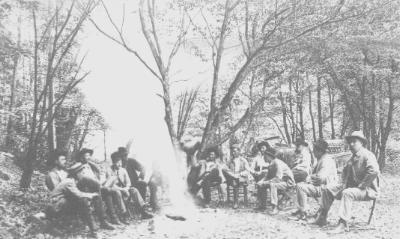
Around the campfire deep in Bear Fork
By Bob Weaver
This is part of a series of stories about the dark and scary
backwoods of this regions wilderness area in "Tales of Bear Fork."
This piece features photographs of activity by members of the Bear Fork Hunting Club in the early 1900's, where
Calhoun men (among other area residents), sometimes accompanied by their wives, would go on hunting retreats for a week
or two at a time, erecting tents for sleeping and cooking . They even had a barbershop and munitions tent.
There are hundreds of critter tales these past 200 years about panthers, bear, wildcats, squirrel, raccoons, fox and
rattlesnake, not to forget deer. Yet today, it is said to have the biggest rattlesnakes ever grown.
It was also a place to catch well developed native fish, a course of food between the red meat.
The photographs have been provided by the kindness of Julia McDonald Jarvis of Mt. Zion, after her father, the late Bernard
McDonald, carefully preserved them. They provide a glimpse of life in the several thousand acres of primitive forest which
rests in Gilmer, Calhoun and Braxton counties.
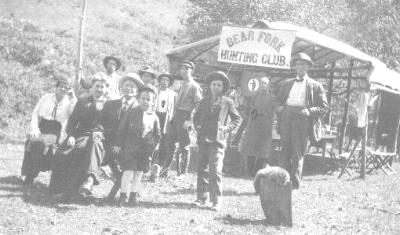
1913: Back (L to R) Clay McDonald, Dewitt McDonald
Front (L to R) Mrs. Ray Morford, Ruth Pell
Miller, Pell Miller and young Bernard McDonald
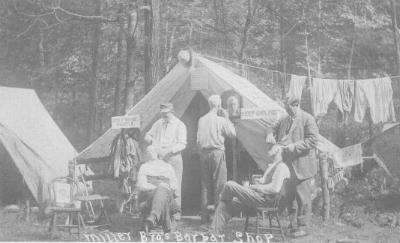
Miller Brothers Barber Shop
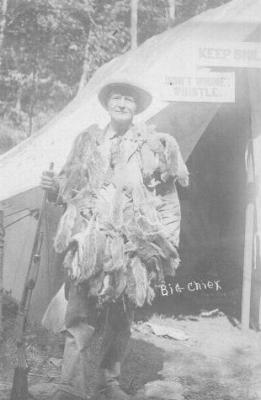
Jules Pell has a big huntin' day
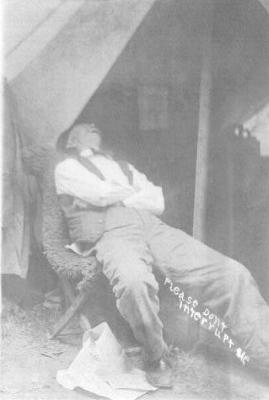
Jules Pell takes a rest
Bear Fork country is still among the most undeveloped pieces of land in western West Virginia, and many folks like it that
way, including the Bear Fork Hunting Club.
Backwoods explorer, Dalton Brady, a descendant of the Calhoun Reips, said he found the sites of five or six houses, usually
identified by their cellar holes. "There is a lot of strange history in those deep woods," he said.
The "Bennett Lands," among the early owners, have been timbered, coal mined, with oil and gas extracted.
For well over a hundred years, the Bear Fork Hunting Club, in it's various incarnations, has had a presence. It is still an active
and vital organization with about 300 members. The club has numerous activities for members and their families, including the
annual "Critter Dinner" held at Arnoldsburg every year.
There are some interesting names for Bear Fork hollows and streams to bring out the best in a hunter, like Twin Hollow,
Copperhead, Point Lookout Run, Standstone Run, Sugar Camp, Groves Hollow (for the Groves family who once resided
there), Plum Tree, Fern Run, Bee Run, Wild Cat, Hooppoles Run, Trace Fork, Riffle's Run, and many more.
Early Bear Fork settler Samuel Lawson, who died in 1935, wrote, "Old Bill Carpenter who lives on Bear Fork of Steer
Creek had the name of being the best hunter in the county, so I went to him for my lessons, and soon learned to bring down
the deer at full speed and to out fox the cunning, sly fox."
"One day my favorite buddy and I were hunting deer along a stream of water when I looked across the stream and saw three
deer coming down for water. I made a sign to my companion and we both cocked our guns and shot at the same time,
bringing down two of the deer. The third made a dive for me across the stream for we had killed his mate. Just before he
reached us I shot again and he fell dead. We carried two of them home that evening and hung the other one in a tree for safe
keeping. I and the old man went back and carried it in," wrote Lawson.
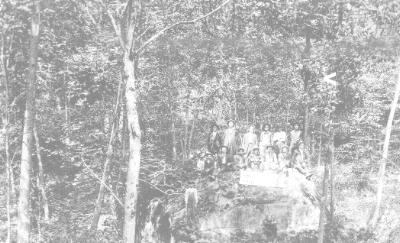
"Chicken Bill Cottrell" is actually climbing (face first) down a tree to the right of the group
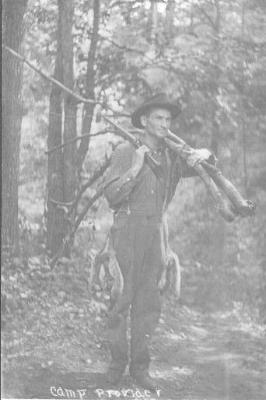
Camp provider Charlie Starcher
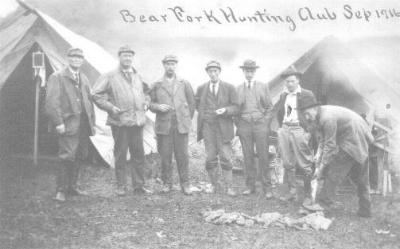
L to R: Julius Pell, Arthur Pell, Clay McDonald, Hunter Pell, Brown McDonald, Unknown and Charlie
Starcher
"I heard a scratching noise inside the stump by which I was sitting and I jumped away. A big rattlesnake came crawling out. I
shot him first, reloading to kill the deer, which I killed too. You can see that there were many dangers connected with hunting
in those days that you don't have now."
I remember another time I was in danger too, and didn't know it. My wife and I were coming in with a deer we had skinned
on Laurel of Bear Fork. We heard a noise behind us, and thinking it was the mate of a deer I was carrying, I began bleating,
hoping to coax it near home so I could kill it also. Near where John Lawson's new home is now being built, my wife who
was behind, began screaming and begging for me to hurry faster," said Lawson.
As I was doing my best, I let her scream. Suddenly we heard a terrific noise and looking around at what was suppose to be
a deer, there was a panther. For some reason unknown to us, the panther lad leaped into a tree and was hanging about 15
feet above the ground. I wanted to try and kill it but my wife forced me to go on home. I took the dogs back and tried to
track it down, but they would not follow the scent," concluded Lawson.
A few families in the 19th and 20th centuries went into the woods and built their itinerant houses, some to spend their
lifetime
One of the fascinating features of the area is the former narrow gauge railroad which was used to haul timber from the area at
the beginning of the 20th century. The railroad actually went up a stream called Bear Fork, and proceeded deep into the
wilderness. The fascination about the Elk and Little Little Kanawha Railroad was the dispelling of the myth that no railroad
was built in Calhoun County. It traveled several miles down the right fork of Crummies Creek, down Frozen and a branch
actually went up Nicut.
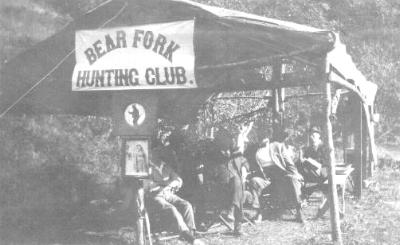
Early 1900 photo Bear Fork Hunting Club
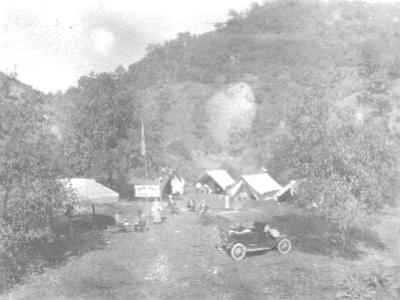
Can you imagine getting an auto into the place?
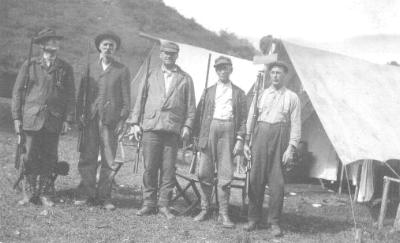
Circa 1912 Bear Fork
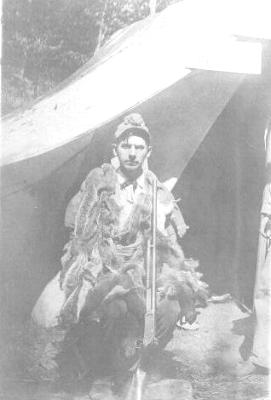
A days kill!
More pictures and stories about Bear Fork under People, Humor and History.
| 


